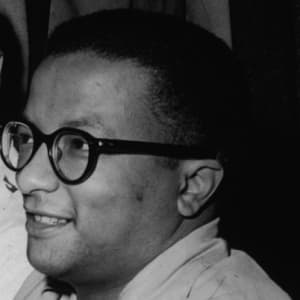
Roger Waters
Roger Waters was the singer, songwriter and bassist for the British rock band Pink Floyd. He also has had an extensive solo career.
Synopsis
British musician Roger Waters was born in Surrey, England, in 1943. While studying architecture in London, he formed the now legendary rock group Pink Floyd with Syd Barrett, Nick Mason, and Richard Wright, and in 1967 they released the classic psychedelic album Piper at the Gates of Dawn. After Barrett’s departure in 1968, David Gilmour joined the group and Waters assumed creative control, serving as its primary songwriter and conceptual architect. For the next decade and a half, Pink Floyd recorded some of the most important albums of the era, including The Dark Side of the Moon (1973), Wish You Were Here (1975) and The Wall (1979). In 1985 Waters left Pink Floyd to pursue a solo career, but at times has enjoyed far more success with his reimaginings of earlier work, including live performances of The Dark Side of the Moon and The Wall. Now in his 70s, Waters continues to tour and record.
Is There Anybody Out There?
Roger Waters was born September 6, 1943, in Surrey, England. His father was a schoolteacher and a conscientious objector who had turned away from his initial convictions as a conscientious objector to join the British army during World War II. He was killed in battle in Italy when Waters was only five months old, and his mother moved him and his brother to Cambridge. Waters attended elementary and high school there, and though he had yet to develop his musical talents, he became friends with two of his future bandmates, classmate Syd Barrett and neighborhood pal David Gilmour, with whom he shared common interests.
After graduation, in 1962 Waters went to London to study architecture at Regent Street Polytechnic, now the University of Westminster, where he met drummer Nick Mason and keyboardist Richard Wright. While pursuing his studies, Waters took up the guitar, and within a year he had joined a group called the Sigma 6, with Mason, Wright, vocalist Keith Noble and bass player Clive Metcalfe. Noble and Metcalfe soon left the group, which went through various other iterations and names, including the Abdabs, the Screaming Abdabs, Leonard’s Lodgers, Spectrum Five and the Tea Set. By 1966, Syd Barrett had joined the group, which had finally settled on the name Pink Floyd.
At the Gates of Dawn
With Barrett serving as its frontman and primary songwriter, Pink Floyd’s sonic explorations and hallucinogenic light shows began to win them a significant following in the emerging psychedelic scene. They quickly signed to EMI Columbia and in 1967 released their first album, The Piper at the Gates of Dawn. Now considered among the most important and influential albums of the era, Piper featured such classics as “Interstellar Overdrive,” “Astronomy Domine” and “Lucifer Sam,” as well the only Waters-penned track, “Take Up Thy Stethoscope and Walk.” Though the album would only scratch the surface of the charts in the U.S., it reached the Top Ten in the U.K.
But, despite Pink Floyd’s budding success, by the time they had release their sophomore offering, A Saucerful of Secrets (1968), Barrett’s steadily deteriorating mental health had led to his departure from the group. He was replaced by his longtime friend David Gilmour, who would serve as both vocalist and guitarist in the group’s new incarnation. For his part, Barrett embarked on a brief solo career before choosing to live in seclusion until his death decades later.
Speak to Me
Despite Barrett’s departure, over the next 15 years, Pink Floyd would record some of the most important and lasting albums of the era. Initially continuing in the chaotic, psychedelic vein for which they had become known, with 1969’s Ummagumma and 1970’s Atom Heart Mother, Pink Floyd changed course with the 1971 album Meddle, which featured the mellower, more commercial, more ambient sound that would characterize much of the group’s future work. This new sound was accompanied by a greater focus on their live shows as well, which included steadily more elaborate light shows and sets.
As the group’s popularity grew, so too did Waters’s control over its creative direction. He was the primary conceptual architect for 1973’s The Dark Side of the Moon, for which he also wrote most of the music and all of the lyrics. Featuring classics such as “Money,” “Breathe” and “Us and Them,” the album was a breakout hit reaching No. 2 in the U.K. and No. 1 in the U.S. Remaining on the charts for more than a decade, it would eventually go multiplatinum and become one of the best-selling albums of all time.
Pink Floyd followed on the heels of Dark Side with 1975’s Wish You Were Here, which was also penned primarily by Waters. In part a tribute to former bandmate Syd Barrett, it featured the tracks “Shine on You Crazy Diamond,” as well as the popular title song, and further established Pink Floyd’s rock stardom, topping the charts in both the U.S. and U.K.
Their next album, Animals—based loosely on George Orwell’s Animal Farm—was less accessible than Pink Floyd’s previous offerings but still topped the charts on both sides of the Atlantic. However, despite their growing success, which now saw the band playing to stadium-size crowds, tensions among its members were beginning to grow as well.
The Wall
Channeling those tensions and his feelings of ambivalence toward Pink Floyd’s stardom, Waters developed the concept for their next album, the rock opera double-album The Wall, which featured the semi-autobiographical character Pink and his experiences in a repressive dystopian society. Released in 1979, the album featured the No. 1 single “Another Brick in the Wall, Pt. 2” and standout tracks such as “Comfortably Numb,” The Wall topped the charts around the world and would go on to achieve multiplatinum status internationally as well. Along with Dark Side of the Moon, it remains one of Pink Floyd’s best-known and best-selling albums.
The success of the album would also lead to an equally popular and critically successful movie. Released in 1982 and directed by Alan Parker, Pink Floyd—The Wall was written by Waters and starred British musician Bob Geldof in the role of Pink.
The Final Cut
But these continued successes did little to resolve issues within the band, and Wright left the group. Shortly after releasing their 1983 album The Final Cut, Waters declared Pink Floyd “a spent force” and in 1984, he released his first solo album, The Pros and Cons of Hitch Hiking—which featured Eric Clapton on guitar—and began touring. The album and the tour were poorly received, however, and Waters lost more than $600,000 on the endeavor.
Waters officially left the group in 1985, and the following year he initiated a legal battle to prevent the remaining members from using the name Pink Floyd. Waters ultimately lost the case, and Gilmour, Wright and Mason continued to tour and record successfully as Pink Floyd. However, Waters did manage to retain full rights to The Wall.
Amused to Death
Carrying on his solo efforts, Waters recorded several songs for the soundtrack of the animated featured When the Wind Blows (1986), which also featured contributions by David Bowie, Paul Hardcastle and Squeeze. The following year, Waters released his second album, Radio K.A.O.S., which fared somewhat better than its predecessor, peaking at No. 25 in the U.K. and No. 50 in the U.S.
In 1990, shortly after the fall of the Berlin Wall, Waters mined his earlier work by staging “The Wall—Live in Berlin,” an elaborate charity concert that included performances by Joni Mitchell, Van Morrison, Cyndi Lauper, Bryan Adams and Sinéad O’Connor, as well as an East German orchestra, a Soviet marching band and U.S. military helicopters. It was attended by hundreds of thousands of concertgoers, and more than 1 billion more watched the television broadcast.
Waters then turned his attention back to new work, releasing Amused to Death in 1992, which featured contributions by guitarist Jeff Beck and vocal appearances by Don Henley. Amused proved to be Waters’s most successful solo album to date, reaching the Top Ten in the U.K. and No. 21 in the U.S.
Return to the Wall
In 1996, Pink Floyd was inducted into the Rock and Roll Hall of Fame, but Waters boycotted the event, due to lingering resentments between him and his former bandmates. Several years later he embarked on a lengthy run of tour dates, at which he played both his solo work and Pink Floyd material. Indeed, much of Waters’s career since has found him vacillating between new projects and reimaginings of earlier endeavors.
In 2004, Waters was heavily involved in a 2004 Broadway adaptation of The Wall and also recorded two new antiwar songs, “To Kill the Child” and “Leaving Beirut.” In 2005, Waters released his first studio album in more than a decade, a three-act opera about the French Revolution titled Ça Ira, and later that same year reunited with Pink Floyd to perform a brief set at the Live 8 benefit concert in London.
The reunion was as brief as their set that night, however, and in 2006 Waters struck out on his own once more for a two-year tour featuring The Dark Side of the Moon. It was so successful that in 2013 he toured The Wall as well, to equally lucrative results. Two years later The Wall was the subject of a documentary film, and in 2016 a new, surround-sound version of Amused to Death won a Grammy Award. Now in his 70s, Waters continues to tour and record and is involved with various charities and activist causes. He lives in Long Island, New York.
Flickering Flame
Waters has been married four times. In 1969, he married his high school girlfriend, Judy Trim. They divorced in 1975, and the following year he married Lady Carolyne Christie. They had two children together, Harry and India, but divorced in 1992. His third marriage, to Pricilla Phillips in 1993, lasted eight years and produced a son, Jack. He married Laurie Durning in 2012, but the couple divorced in 2015.
Waters’s son Harry is a pianist who has played on tour with Waters since 2002.




